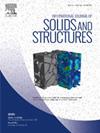Thermoelastic behavior analysis of finite composites embedded in ellipsoidal inhomogeneities with inclusion-based boundary element method
IF 3.4
3区 工程技术
Q1 MECHANICS
International Journal of Solids and Structures
Pub Date : 2024-11-29
DOI:10.1016/j.ijsolstr.2024.113172
引用次数: 0
Abstract
The thermoelastic properties of composites play a pivotal role in various practical engineering challenges. This paper employs the inclusion-based boundary element method (iBEM) to analyze the thermoelastic field and predicts the influence of key parameters in the particle phase on composite properties. Utilizing the equivalent inclusion theory, material mismatch effects are characterized by eigenstrain and eigen-temperature gradient. Incorporating the boundary integral equation, the boundary effects are addressed, which facilitates the computation of internal field outcomes via stress and heat flux equivalent conditions. Validation against finite element and experimental data confirms the efficacy of iBEM in accurately simulating thermoelastic behavior and predicting effective properties of particle composites. Noteworthy findings indicate that optimal composite properties align with the long axis orientation of ellipsoidal particles, while the particle distribution significantly impacts the effective Poisson’s ratio.
求助全文
约1分钟内获得全文
求助全文
来源期刊
CiteScore
6.70
自引率
8.30%
发文量
405
审稿时长
70 days
期刊介绍:
The International Journal of Solids and Structures has as its objective the publication and dissemination of original research in Mechanics of Solids and Structures as a field of Applied Science and Engineering. It fosters thus the exchange of ideas among workers in different parts of the world and also among workers who emphasize different aspects of the foundations and applications of the field.
Standing as it does at the cross-roads of Materials Science, Life Sciences, Mathematics, Physics and Engineering Design, the Mechanics of Solids and Structures is experiencing considerable growth as a result of recent technological advances. The Journal, by providing an international medium of communication, is encouraging this growth and is encompassing all aspects of the field from the more classical problems of structural analysis to mechanics of solids continually interacting with other media and including fracture, flow, wave propagation, heat transfer, thermal effects in solids, optimum design methods, model analysis, structural topology and numerical techniques. Interest extends to both inorganic and organic solids and structures.

 求助内容:
求助内容: 应助结果提醒方式:
应助结果提醒方式:


